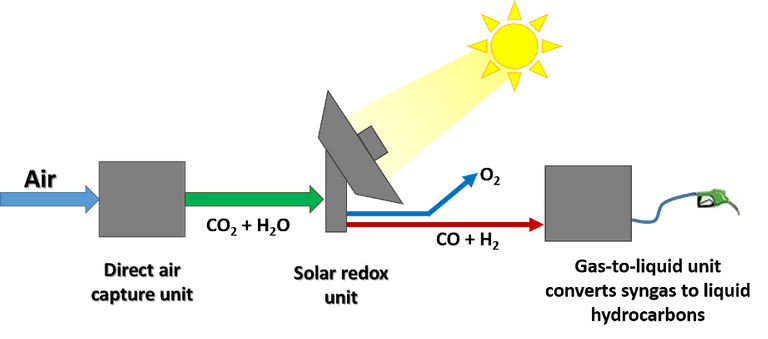Fuel from air
We know that our planet urgently needs a change of energy model, we need to stop consuming fossil fuels that release tons of CO2 and greenhouse gases into the environment accelerating global warming, and although great advances have been made in the development of electric vehicles and energy systems from renewable sources, even vehicles such as aircraft, ships and heavy cargo vehicles need fossil fuels because they have not developed electrical systems that can meet their energy requirements and autonomy.
In this sense, we need alternative sources to produce hydrocarbon-based fuels without having to add more pollutants to the environment, and it seems that a group of Swiss researchers have made a breakthrough, designing a method that can produce fuels from CO2, atmospheric water and the sun, so basically the raw material is in the air.

The raw material for this fuel is in the air. Source: pixabay.com.
Although zero-emission transportation is possible through electric vehicles powered by rechargeable batteries, for shipping and aviation it is a real challenge to use this type of technology because of the distances they must cover without stopping, so the solution could come from a less explored type of fuel, the so-called synthetic fuels, which have been proposed as alternatives to gasoline and diesel.
These synthetic fuels are hydrocarbons that are produced solely from CO2 and hydrogen by thermochemical means; the combination of these two compounds can produce a hydrocarbon chain from which fuels can be obtained. But although the theory has been known for some time, it has not yet been possible to build equipment efficient enough to exploit the process industrially.
But researchers at the Swiss laboratory ETH Zürich have achieved a breakthrough, designing a method that mimics photosynthesis, by which atmospheric CO2, water and sunlight are absorbed, converting this raw material into organic compounds, these results have been published in the journal Nature.
The process developed by this team of researchers consists of taking CO2 and water from the atmosphere and storing them and then putting them in contact with a basaltic rock that absorbs the unwanted carbon; in a next step, concentrated sunlight is used to heat a material based on cerium oxide, which, when heated to a certain temperature reacts with CO2 and water, this reaction produces CO from CO2 and hydrogen from water, generating oxygen as the only byproduct of the process, which can be safely vented to the atmosphere.

General scheme of operation of the prototype. Image created in PowerPoint.
Then, the mixture of CO and hydrogen is called synthesis gas, and is used as raw material to obtain liquid hydrocarbons, such as kerosene or gasoline, through a chemical process known as Fischer-Tropsch process, which consists of a series of polymerization reactions, where CO is absorbed over a catalyst giving rise to hydrogenation and initiation of polymerization through the formation of a methyl radical, to end with a condensation polymerization.
So far the ETH research group's prototype has managed to produce pure methanol by running their equipment on the roof of the laboratory, and although they have only managed to produce 32 mL of methanol in 7 hours of operation of the equipment, which is very small if one is thinking of replacing fossil fuel, it is proof that the system works and it is possible to produce a hydrocarbon using feedstock from the air and sunlight.
This type of approach is necessary, since most of the solutions thought of involve the electrification of the transportation system, but this is a solution that may take longer than we would like to replace the world's entire vehicle fleet, so with a fuel that is not derived from fossil hydrocarbons and whose carbon balance is zero, it could be a short-term solution.
For now let's hope that this type of process is developed enough to make it economically viable and industrially efficient to produce fuels in magnitudes similar to the fossil fuels produced today.
Thanks for coming by to read friends, I hope you liked the information. See you next time.
Hi @emiliomoron .
It is good that new strategies are being developed in favor of improving our environment, from which we all benefit and few take care of.
The production of carbon dioxide (CO2) is one of the big problems of our environment, since vehicles and factories are the main sources of emissions and as we can see in our environment are many.
We are infinitely grateful to the different entities that carry out research in favor of reducing this production of pollutants.
Greetings and thank you for sharing such valuable information.
Greetings @sidalim88, thanks to you for reading. No doubt it is necessary to develop strategies that help us to improve environmental conditions, and fossil fuels have only helped in its deterioration, hopefully this and new research will lead us to develop fuels with a zero carbon balance.